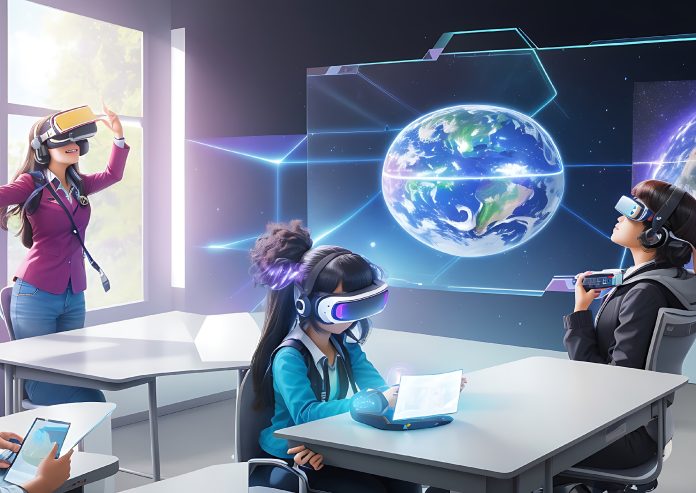Envision yourself in the Great Wall of China without leaving your classroom, pealing apart a virtual frog in 3D, or following the dinosaurs in their prehistoric environment. This is not imagination; this is real Virtual Reality Education that transforms the world. VR learning is the new revolutionary educational tool that has replaced dull lectures with live one-on-one interactive learning that makes things creative and improves the retention of knowledge. However, once we come to the moment of excitement, some issues and points need to be assessed and addressed.
This blog walks you through Virtual Reality education in depth, talking about both the benefits and the challenges of this innovative approach. We’ll have a deep discussion on its influence over different areas, demonstrate relevant real-world examples, and provide knowledge that will help you utilize VR in your learning environment. In other words, grab your seat safety belt and travel with me to a fascinating realm of virtual reality education! Well, it is our prime task to respond to your queries, help exchange the innovations’ expertise, and show the hidden opportunities of this revolutionary tool.
What is Virtual Reality in Education?
With an increasing number of schools embracing virtual reality, or VR, the technology is exploding in education. VR enables students to explore global destinations without ever leaving the classroom. Imagine students exploring the pyramids of Giza while seated at their desks. This is what virtual reality can do for education. VR (virtual reality) is common knowledge, but most people don’t know what it is or how it is used for learning. The term ‘VR’ refers to interactive content (images or videos) that gives the viewer a 360-degree view of the image.
The VR in education is going beyond immersion and is kind of transmitting education as well. As more schools opt for VR curriculums, the interesting and interactive learning opportunities will be countless. VR industries participate in this transformation having a pivotal role by producing various VR content that will visualize the experiences and enhance comprehension of the subject.
A VR company can provide an extra level of creativity in VR-based education, where they can engage and collaborate on a connected virtual platform. As a result, VR and metaverse development fields help the process implement novel technologies in education creating new exciting opportunities for students to travel and study in an entirely new way.
Virtual Reality Applications in Different Subjects:
The flexibility of VR makes it applicable to various disciplines, delivering engaging and enriched learning through different educational strategies.
1. STEM Education
There is no other way in the areas of Science, Technology, Engineering, and Mathematics (STEM) to study high-level issues but VR makes it possible. Chemistry and biology can be analyzed, viewed, or changed, as well as real-life engineering problems, all from a virtual environment. The hands-on engagement with abstract concepts helps to demystify even the hard topics, igniting the love for sciences.
2. History And Social Sciences
Virtual Reality education allows students to go back in time or travel the world, giving them the chance to look at past events or different cultures. The students can stroll through ancient civilizations, witness moments that changed the history of the world, and feel the reality of the cultures. This will help them grow both vast and deep knowledge. This hands-on process in the textbooks revives them as history and social studies become more accessible and memorable.
3. Language Learning
Learning languages through VR transcends the walls of the traditional classroom by placing students in real conversations that occur in real life. Think of learning French while strolling through the streets of Paris or perfecting Spanish in a virtual marketplace in Madrid. Language learning can be made fun and effective with these interactive activities that provide meaningful context and immediate feedback.
4. Art And Design
Artists and designers of tomorrow see VR as a boundless canvas and unlimited toolbox. Students can create 3D art, design buildings, and have a virtual tour of galleries from different parts of the world. It not only refines their creative talent but also makes them knowledgeable about global artistic trends and histories. In addition, virtual reality enables the exploration and discovery of artistic and design ideas differently from what is achievable in traditional classrooms, which brings about innovation and creativity.
Benefits of Virtual Reality in Education:
1. Immersive Learning Experience
The traditional classroom setting may not always get the students to pay attention. Nevertheless, with the help of virtual reality, students could be sent to different places, ages, and situations, which would provide them with a deep learning experience. For example, history class can be made more interesting by “visiting” ancient civilizations or “live” taking part in historical events. Besides, the practice-oriented approach not only provides students with deep knowledge but also makes learning more fun.
2. Virtual Field Trips
Beyond the boundary of the classroom, field trips provide a real experience of education for students. However, the expenses and problem of arranging school trips can be a hurdle. With virtual reality, students can visit national parks, museums, and even different countries virtually, simulating the experience of being on a field trip without leaving the classroom. This not only changes the boundaries but also makes globalization the core.
3. Enhanced Engagement
The biggest problem with teachers is holding the students’ attention. Virtual reality education easily hooks up the students’ minds through being interactive and having a VR experience. In that way, science classes can be turned into virtual ones, allowing students to perform their experiments at the safety of their screen. This hands-on approach allows for higher student engagement and yields a thorough comprehension of such complex concepts.
4. Personalized Learning
It is known that every person has its method of learning and self-paced learning. Virtual reality is a technology that enables students to have a one-on-one session with a tailor-made learning experience for their specific needs. Students can set their own pace, have a lot of freedom to venture into interesting adventures, and get immediate feedback. This individual approach is delivered through the relevant course materials and activities that are adjusted to each student’s interests and capabilities which results in faster learning.
5. Empathy And Social Skills
Virtual reality can create empathy and also develop social skills. By experiencing the world through the eyes of a person from a different cultural background, learners develop empathy and understanding. As well as improving communication skills and teamwork abilities, virtual reality technology provides students with collaborative learning opportunities.
Challenges and Limitations of Implementing Virtual Reality in Education
Virtual reality (VR) is endowed with rich possibilities for revolutionizing education through the grant of multimodal and interactive learning environments for learners. Nevertheless, there are some practical limitations and disadvantages that should be taken into consideration to efficiently use VR in an educational framework.
High Price Tag And The Equipment Bulkiness
Entry level into VR solutions remains the biggest obstacle to the mainstream adaptation of VR in education, which can be attributed to the high cost of VR technology itself. Schools are suffering from a lack of budgets which undermines their capability to invest in VR tools such as headsets, and sensors among other equipment. Furthermore, the size of VR devices might be too big to be comfortable for students and they can limit their support in the classroom.
To address This Challenge
The availability of free VR equipment like Google Cardboard viewers and systems that can be used on smartphones are among the ways that schools with smaller budgets can introduce VR to their classrooms.
Technical Problems And Compatibility Issues
The VR technology still largely remains undeveloped and evolving, so problems such as glitches and compatibility with other devices may appear more often. They become a hindrance in the learning experience and make students and teachers both upset.
To Address This Challenge
Sustaining the VR systems to be stable, user friendly, and supporting the classroom technology already deployed is the key factor for a smooth integration.
Scarce Availability of Qualified Educational Content
The development of quality educational content is one of the world’s challenges facing VR in the educational system. There are several high-quality VR applications dedicated to education, but they lack a variety of topics and levels. The teachers can face an uphill task to find a correct VR activity that matches their curriculum and learning objectives.
To Tackle This Challenge
Collaboration between VR enterprises and educational institutions can give rise to the development of a more diverse range of rich content.
VR Access in Schools Has Been Restricted
Even though the use of VR in education might provide many positive outcomes, hyper-reality devices are still not available or very expensive to install in most schools nowadays. While some schools could lack the necessary infrastructure or internet connection needed for the implementation of VR education, others may have already embraced this disruptive technology. As well as that, state policy may be a hindering factor or people may mind the question of student safety and privacy that will prevent VR from fully flooding the market.
Students And Educators Are Working to Make VR More Accessible
Training sessions and resources for the teachers on how to use VR technology with effectiveness can support them in their implementation of this technology into their teaching. By solving these issues and breaking down the barriers to using Virtual Reality education we can therefore enhance its effectiveness as a tool that helps students absorb information through interactivity.
Conclusion
Virtual reality has become an educator’s dream tool; it offers students an unforgettable experience of fully immersive learning. Through building up the level of education engagement, experiential learning, and inclusive education, VR can dramatically transform today’s classrooms. It is possible to overcome the challenges with affordable technologies, comprehensive training, and content development, enabling virtual reality education to reach its full potential. Harnessing future improvements facilitates individualized learning journeys and collaborative settings that are a starting point for bringing in an exciting new era of learning. In what ways can you envision immersive learning completely changing your learning journey and how is it going to be applied in the class you are attending now? Do you agree with our opinion on the movie’s scenic settings? Please share your ideas and comments below!





